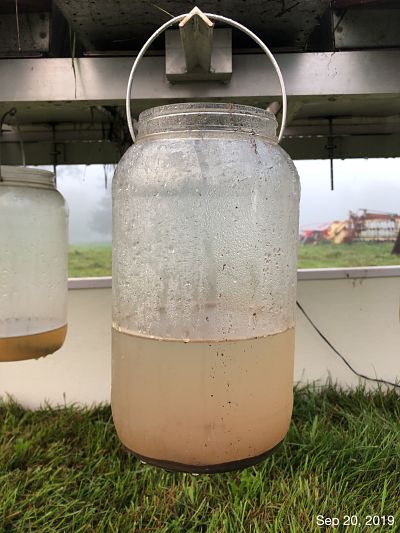Total Suspended Solids
What are Suspended Solids?
- Suspended solids are fine particles of sediment in the water.
- Examples: soil, biological solids, decaying organic matter, and particles discharged in wastewater. (Water Research Center)
What is Total Suspended Solids?
- Total suspended solids (TSS) is a measure of the total solids greater than 2 microns suspended in the water column. Anything smaller than 2 microns is considered a dissolved solid. (US EPA – Total Solids)
- The Northeastern Lakeshore Total Maximum Daily Load (TMDL) calculates sediment concentrations by estimating and measuring TSS. Managers use those measurements to assess how impaired a waterway is, and develop plans to reduce those numbers to meet water quality standards.

Some soil in this water has settled out at the bottom of the jar, but the water is still cloudy due to solids suspended in it. This is how many of our waterways look after rain event washes sediment off fields.
Image Credit: Derrick Raspor.

Sediment flowing from the Sheboygan River into Lake Michigan at Sheboygan harbor.
Image Credit: Sheboygan County 2019 airphoto flight.
How do Suspended Solids
Enter Our Waterways?
Rain events that cause surface runoff can carry sediment and other solids suspended in the runoff into our waterways.The removal of natural vegetation and having bare crop fields during the non-growing season contributes directly to increased erosion and sedimentation, which leads to higher levels of total suspended solids.

Sediment flowing from the Sheboygan River into Lake Michigan at Sheboygan harbor.
Image Credit: Sheboygan County 2019 airphoto flight.
Why Should We Care About
Total Suspended Solids in Our Waterways?
Environmental
- Reduced water clarity, caused by suspended solids in the water, decreases visibility for fish and diving birds, making it more difficult for them to find food.
- Suspended solids can clog fish gills and cause increased levels of stress.
- Suspended solids that settle at the bottom of a river or lake can bury fish eggs, fish nursery areas, and invertebrate habitat, which can negatively impact the food chain.
- Increased sediment reduces water clarity. Less light is able to penetrate the waters’ surface and reach aquatic plants. Reduced sunlight reduces photosynthesis activity and oxygen production, which can create hypoxic (low-oxygen) conditions and contribute to dead zones.
- (Water Watch)
Economic
- Suspended solids settle at the bottom of a water body, creating shallow waterways. Increased sedimentation can impact recreational activities, leading to reduced income in local economies. Waterways can be dredged to remove excess sediment, but this is a costly and continuous project.
